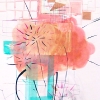
So maybe the stereotype of the poor, angry, and frustrated artist has got to end, but the topic of anger keeps turning up in my conversations lately.
Irritation, frustration, and all the other variations, too. It’s the New Year and things are supposed to be shiny and fresh, people are supposed to still be tolerant, and we’re supposed to be enthused by all our goals for the year ahead. But yet, on a macro level, tension is high and people are angry. On a micro level, I’m exploring where my anger over small things (and big things) comes from. Trying to teach my son that feeling anger and expressing it (like with a whop to his sister’s head) are two different things. Discussing anger with a friend, I shared the idea that the misuse of anger takes away power, but using it creatively could be powerful.
The anti-anger experiment
I did an experiment a few weeks ago. For three days, I didn’t get angry. At anything. Even when stuff broke in our house and it was valuable. It felt really good, like a caffeine or sugar cleanse does – not so pleasant, but with great benefits. I channelled my frustration and annoyance into being a better mom, cranking out word count, and handling a cranky Sunday at the Deniz household with grace. And then I lost my grip on it. Too many demands, too little sleep. My irritation got triggered and enough was enough – keeping it all inside only meant I was holding it back, not transforming it.
Except that I had learned the difference between a knee-jerk reaction and something simmering that could, and needed to change. Something that could make change. Could draw me deeper into the words on the page or the canvas. Not getting angry in an external way gave me my power back. I put the power of anger to good use in my work.
Do angry artists make better work?
People like people who are not angry, but we like emotional artwork, paintings and songs packed full of angry things: heartbreak, hurt, loss, fists shaking at the sky for being duped (thanks, Kathy). Then there are amazing, talented people who want to take their anger with them, and use it. Who use anger as a medium, rather than a force.
Take for example this sublime animated street art project in Turkey, Judith Bernstein’s angry work about the art establishment being male-centered, and Chris Ofili’s work that is angry about race and sexual stereotypes. After a bad break-up in graduate school, I made paintings of explosions. They were pink, though, and kinda pretty, but they were spectacularly angry. When I’m really stressed, I embroider, and the motion of thread through fabric releases all my tension. Being quiet in anger doesn’t make it less moving.
When anger, irritation, and frustration becomes a medium, rather than a crutch or a danger, beautiful things can happen.